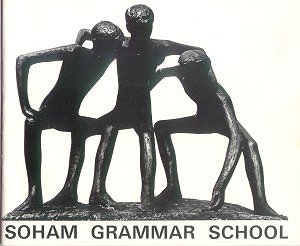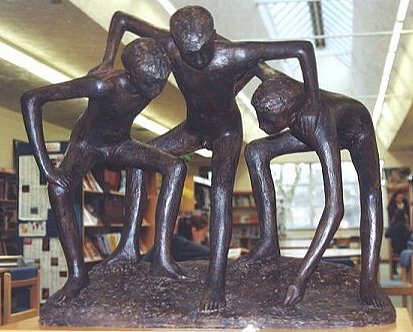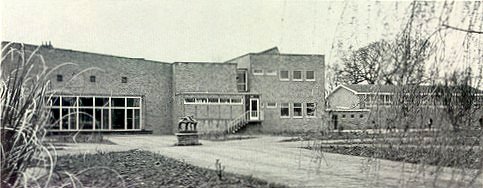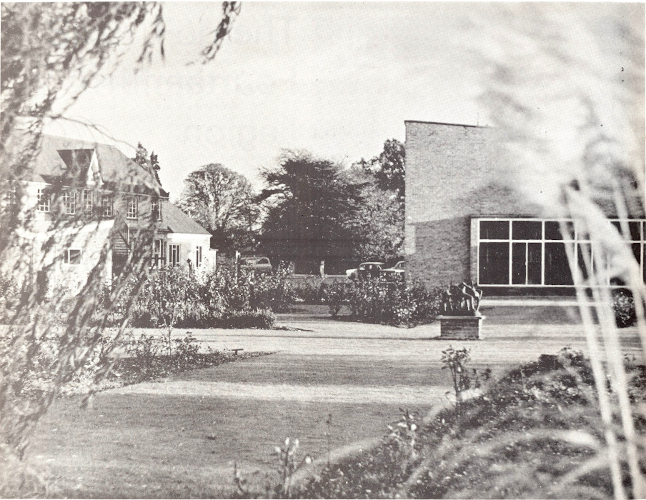if you have more information about this
sculpture please contact the editor.
page updated 20 Mar 2003: 23 Oct 19
 cover of 1970 Soham Grammarian: source Haslam |
 Three Boys Bending Over a Pool, year unknown, bronze by Betty Rea in the Resource Centre, Soham Village College: source Haslam It is understood to now be in the Reception area in Beechurst. |
The School History states that "in 1964, £1268 was collected, again mainly from a Summer Fair, to build the Scout Hut, to make purchases of musical instruments and a sculpture...." The Three Boys were featured on the cover of the 1970 magazine and a photograph inside showing it in place in the gardens, but there was no mention in the text of its provenance. The statue was bought on the recommendation of the artist Nan Youngman, who may well have been the Arts Advisor - she was certainly in the forefront of art education in the county and beyond.

The new buildings (hall & labs 1957, gymnasium on right 1963)
with the Three Boys bronze on a plinth in the garden, ca
1966

from the Summer 1970 Soham Grammarian
Mike Rouse, who began his
long stint on the staff of the Village College in 1966 takes up the
story: Sadly, vandals knocked the bronze off its brick plinth and it
was damaged. As the site was being developed the bronze was put into
storage. Eventually for some reason we had to find it [In his 2019
Reunion talk Mike added that news came that the
original had been stolen from a
garden in the Cambridge area. Soham Village College had a
version of it - was it still in place, as it had more significance and
value now?].
I discovered it in a rather sorry condition in what were the greenhouses that once were between Addison House and Beechurst. With the agreement of the then Principal I arranged for the damage to be repaired and for the bronze finish to be restored.
I met Nan Youngman (see above) who provided
support during the restoration for the opening of the Soham Village
College Resource Centre and she was delighted that it was being given
a new place of honour.
Ours was displayed on a splendid wooden
plinth (kindly provided at no cost by the late Grammarian Reg Brown of
the Soham funeral directors CE Fuller & Co. and made by one of his
craftsmen) in our Resource Centre. The text shown below about the
sculptress Betty Rea is part of this display.
It is now (2019) in Beechurst's foyer area.
BETTY REA 1904-1965
Betty Rea was born in London in 1904. Her father was Dr Arthur Bevan, and her mother's maiden name was Bernardo; Dr Bernardo was her great-uncle. She was educated at Downe House School (in Kent at that time), and began to study painting at the Regent Street Polytechnic in 1922, almost at once changing to sculpture and transferring her studies to the Royal College of Art in 1924. Her teacher there was Ernest Cole. Henry Moore was a student teacher at the RCA at that time, and became a friend.
In 1926 she married James Rea, whose father became Lord Rea, the Liberal peer, and two sons, Nicholas and Julian, were born in 1928 and 1931. Her husband died in 1954.
During the 'thirties, Betty Rea was greatly involved in anti-fascist, leftwing political issues, like so many of her contemporaries. Her activities were always directed towards the prevention of war, and to the work of the Artists' Refugee Committee. From 1934 to 1936 she was secretary of the Artists' International Association.
For the greater part of the war, Betty Rea taught painting and modelling in evacuated children's homes in Huntingdon and the surrounding country. These children's paintings were included in several British Council exhibitions sent abroad, and some are illustrated in Herbert Read's "Education Through Art .
As well as these demanding occupations, she was bringing up her sons and, for some years, three young children of a friend who died during the war. Shortly after moving to Cambridge in 1946 she became able to work more consistently at sculpture and in 1949 to teach sculpture at Homerton College, continuing this part-time until 1964.
Betty Rea also worked for some years as craft examiner for the Cambridge Local Examinations Syndicate, contributing a great deal to the general raising of standards in the teaching of sculpture and crafts in English schools, as well as abroad. She had herself, while first in Cambridge, worked successfully in producing hand-printed textiles.
Betty Rea died in 1965.